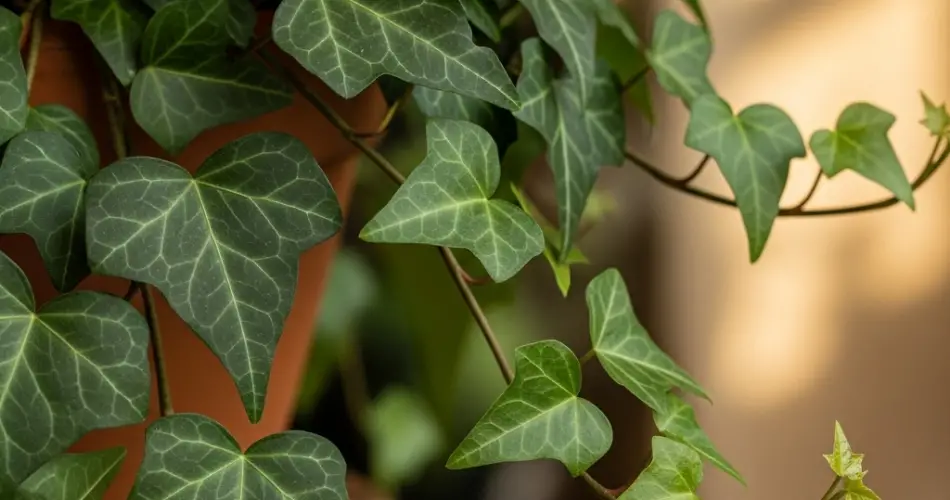English ivy (Hedera helix) is a timeless classic in the world of indoor plants. Known for its trailing vines and attractive lobed leaves, it adds elegance to bookshelves, windowsills, or hanging baskets. Outdoors, it is often seen climbing walls and fences, but indoors, it is equally admired for its air-purifying qualities and ability to adapt to different conditions. One of the most common questions plant owners ask is whether English ivy can thrive in low light environments.
The good news is that English ivy is more adaptable than many other houseplants and can survive in low light. However, while it tolerates shade, its overall growth and vibrancy are strongly influenced by the type and amount of light it receives. To better understand how to care for this versatile plant, let’s explore how English ivy responds to low light and how you can help it stay healthy in such conditions.
Natural Habitat and Light Preferences
In its native environment across Europe and parts of Asia, English ivy grows as a climbing or groundcover plant in forests, often thriving under tree canopies where sunlight is filtered. This natural adaptation explains why it can tolerate lower light indoors. However, in the wild, ivy still benefits from some indirect brightness to fuel its climbing growth.
Indoors, the plant generally prefers bright, indirect light, though it can adjust to medium or low-light rooms. The key is finding the balance between survival and optimal growth.
Can English Ivy Grow in Low Light?
Yes, English ivy can grow in low-light spaces, but with limitations. In dim conditions, the plant’s growth rate slows, and the leaves may become smaller and less vibrant. Variegated varieties, in particular, may lose some of their striking white or yellow patterns, reverting to plain green in order to photosynthesize more efficiently.
In very dark spaces, such as interior rooms without windows, English ivy will struggle to stay healthy unless you provide supplemental lighting.
How Light Levels Affect English Ivy
The amount of light your ivy receives directly impacts its appearance and vitality:
-
Low light: Slower growth, reduced variegation, and fewer new shoots. Leaves may appear darker green but less lively.
-
Bright, indirect light: Healthy, vigorous growth with fuller vines and defined leaf patterns. This is the ideal condition.
-
Direct sunlight: Prolonged exposure can scorch leaves, especially indoors through hot south- or west-facing windows.
Understanding these differences can help you adjust your plant’s location based on the effect you want to achieve.
Tips for Growing English Ivy in Low Light
If your home or office has limited natural light, there are still ways to help English ivy thrive:
-
Choose the right spot
Place your ivy near the brightest window available, even if it’s north-facing. Avoid deep corners far from light sources. -
Supplement with grow lights
Full-spectrum LED or fluorescent grow lights can keep ivy healthy in dim spaces. Position the light 12–18 inches above the plant and keep it on for 10–12 hours daily. -
Rotate the plant
Turning the pot every week ensures even light exposure, preventing uneven or leggy growth. -
Prune regularly
In low light, ivy tends to grow thin and leggy. Pruning helps encourage fuller, bushier vines. -
Avoid overwatering
With reduced light, ivy uses less water. Let the top layer of soil dry out slightly before watering again to prevent root rot. -
Clean the leaves
Dust can block precious light from reaching the foliage. Gently wipe leaves to maximize photosynthesis.
Varieties Best for Low Light
While all English ivy varieties can adapt to different conditions, plain green cultivars tend to handle low light better than variegated ones. If your space is dim, choosing a solid green variety may give you a healthier and more resilient plant. Variegated types are better suited to brighter spaces where their leaf patterns can remain vibrant.
When Low Light Isn’t Enough
If your ivy starts looking weak despite your best efforts, it may not be getting the light it needs. In such cases, moving it closer to a window or adding artificial lighting is essential. English ivy can survive for a while in very low light, but to truly thrive and maintain its lush appearance, some level of brightness is always necessary.
Final Thoughts
English ivy is an adaptable and resilient houseplant that can tolerate low light better than many others. While it may not grow as vigorously or display its full variegation in dim spaces, it can still survive and provide greenery in rooms with limited brightness. With thoughtful placement, supplemental lighting, and careful watering, you can keep your ivy healthy even in low-light environments.
If you want lush, vibrant growth, aim for bright, indirect light whenever possible. But if your home has fewer sunny spots, English ivy remains one of the best plants to bring nature indoors—beautiful, hardy, and forgiving in a variety of conditions.



